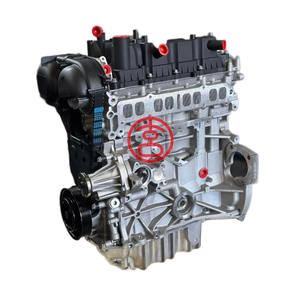Exploring the Development of Engines: From Classic Layouts to Modern Marvels
From the preliminary heavy steam engines that powered the Industrial Transformation to the development of internal burning engines that changed mobility, each phase has contributed to better effectiveness and capacity. As we take a look at these landmarks, one must think about exactly how the future of engine style might unravel, testing our assumptions of power and effectiveness.
The Birth of Engine Technology
The arrival of engine technology noted an essential moment in human technology, transforming power conversion and transport. The earliest engines arised from the demand to harness mechanical power for practical usage, leading to the advancement of tools that converted different energy kinds right into activity (ford fiesta engine).
The advancement of the interior burning engine and the innovation of the vapor engine catalyzed a profound change in commercial capabilities. These engines not only boosted effectiveness yet additionally expanded the range of human movement, allowing unmatched transportation possibilities. The very early prototypes prepared for the mechanical world, helping with the rise of industries and improving societal frameworks.
As engine styles developed, they included cutting-edge materials and advanced design principles, leading the means for modern advancements - ford fiesta engine. The birth of engine technology fired up a relentless quest of effectiveness and power, setting the phase for the dynamic evolution of transport and commercial equipment that would certainly adhere to
Heavy Steam Engines and Their Influence

The vapor engine's impact was particularly noticeable in the transportation market (ford fiesta engine). Steam-powered locomotives promoted the fast motion of products and people throughout substantial ranges, efficiently diminishing the geographical obstacles that had actually formerly impeded profession and communication. Steamships reinvented marine traveling, allowing for quicker and more dependable crossings of rivers and seas.
In sector, vapor engines powered manufacturing facilities, making it possible for mass production and the rise of metropolitan centers as hubs of financial activity. Heavy steam technology promoted innovations in engineering and production processes, laying the foundation for future advancements in engine layout.
The Increase of Internal Burning
Regularly eclipsing vapor power, the rise of inner burning engines marked a transformative change in transportation and industry throughout the late 19th and very early 20th centuries. The growth of these engines, identified by their capability to melt fuel within the engine itself, allowed greater effectiveness and power contrasted to typical vapor engines. Pioneering developers such as Nikolaus Otto and Rudolf Diesel played essential duties in improving engine layouts, resulting in extensive fostering in vehicles, boats, and commercial machinery.
The inner combustion engine's portable dimension and reasonably lightweight nature assisted in the introduction of individual vehicles, transforming specific movement and reshaping urban Look At This landscapes. By making it possible for faster traveling and the reliable transportation of products, these engines militarized financial development and cultivated globalization. The versatility of fuel options, including gas and diesel, better boosted their allure, enabling varied applications throughout various markets.
Despite the environmental issues that would later on develop, the preliminary appeal of inner burning innovation lay in its transformative possibility. As culture accepted this technology, the structure was laid for contemporary transport systems, developing interior burning engines as a keystone of commercial innovation and life throughout the 20th century.
Developments in Engine Efficiency
As internal burning engines ended up being important to transportation and industry, the emphasis shifted towards boosting their effectiveness to meet growing needs for efficiency and sustainability. Advancements in engine layout, material scientific research, and innovation have substantially contributed to this advancement.
One major development is the growth of turbocharging, which permits increased air consumption, leading to even more total gas burning and enhanced power outcome without increasing the size of engine size. Furthermore, variable shutoff timing systems have been carried out to optimize engine efficiency across numerous RPM ranges, therefore improving gas efficiency.
The application of advanced gas injection modern technologies, such as straight shot, has actually also played a vital duty. This approach permits more exact control over the fuel-air combination, promoting far better burning and lowering discharges. Light-weight materials, consisting of aluminum and composite elements, have actually been taken on to reduce total engine weight, leading to improved effectiveness.
These developments mirror a wider fad within the auto industry, where the harmony between engineering technology and environmental considerations drives the continuous mission for higher performance in internal burning engines. Therefore, modern-day engines are currently more effective, cleaner, and reliable than ever, paving the means for an extra lasting future in transport.
The Change to Electric Power
With expanding issues over environmental effect and fossil fuel dependency, the automotive industry is experiencing a significant shift in the direction of electrical power. This change is driven by a mix of technological developments, regulative pressures, and changing customer choices. Electric lorries (EVs) supply an engaging choice to conventional inner burning engines, flaunting reduced greenhouse gas exhausts and lower operating costs.
The check these guys out rise of battery modern technology has actually been a game changer, with lithium-ion batteries becoming extra effective and cost-effective. Enhanced power thickness and faster billing abilities have actually made EVs a lot more functional for everyday usage. Furthermore, governments worldwide are carrying out incentives and establishing enthusiastic targets for eliminating fossil fuel automobiles, thereby speeding up the fostering of electric power.
As charging facilities expands and battery modern technology proceeds to boost, the shift to electrical power is hop over to these guys positioned to reshape the automobile landscape, promoting sustainability and development in the years to come. The future of transport is electrical, and the momentum is indisputable.
Verdict
The advancement of engine modern technology stands for a significant trajectory of advancement that has actually exceptionally influenced transport and market. From the foundational heavy steam engines to the transformative interior combustion engines, each advancement has actually contributed to boosted flexibility and financial growth.
